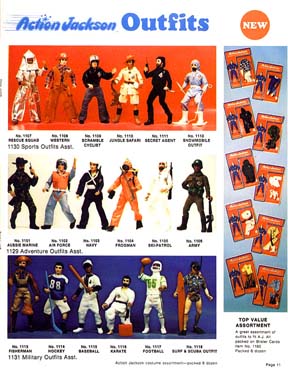 Toy Fair 1973: Mego enters the arena of industry players, promising a television-heavy campaign for Action-Jackson and Dinah-Mite in a direct challenge to GI Joe and Barbie.
Toy Fair 1973: Mego enters the arena of industry players, promising a television-heavy campaign for Action-Jackson and Dinah-Mite in a direct challenge to GI Joe and Barbie.
It was a heady time for Mego. The company was making a giant leap after almost 2 decades as a small toy distributor in the dime-stores and discount shops across the country.
The learning curve proved to be quite steep. Their first foray into major television advertising was nearly fatal. They were sued by Hasbro. Simply getting products made in Asia was difficult enough; Getting them made correctly took years…
Mego had a few things going for it, however. A young and ambitious management team, the right connections with licensing agents, and solid experience with polyester knits.
It’s true. Mego’s trading agent in Hong Kong was Lion Rock Trading, and one of Lion Rock’s many ventures was producing and importing ladies undergarments and 70’s LEISURE suits to Britain. This proved beneficial when it came to producing fabric costumes for their dolls and action-figures. It also explains why it can be difficult to find matches for Mego materials today. Megos were made with cutting edge 1970’s fabrics that for some reason have fallen out of favor today….!
They were further connected with the production routes for tooling and molding plastic. For several years the company did not own it’s production facilities in Hong Kong, but instead contracted to have goods produced. While this system had it’s drawbacks in terms of how much control Mego had over production, it was very successful for a number of years. Mego finally opened a state of the art factory in Hong Kong in 1977-78, only to see interest rates hit 21%, thus exacerbating the problems that would eventually shut the company down.
 Action Jackson: You Can’t DO That On Television!
Action Jackson: You Can’t DO That On Television!
The idea for the figure came from the company’s founder, D. David Abrams, who also happened to be a New York Knicks fan. At the time, the so-called sixth man on the World Champion Knicks was Phil Jackson, who would later coach Michael Jordan and the Chicago Bulls to 5 NBA Championships. The New York press had given him a catchy nickname that David Abrams thought would make a good moniker for their new toy line. “Action Jackson” was born.
“The biggest little man in the world of adventure” was clinging to life by 1973. The line encountered a near-fatal disaster the previous year. As it was their first foray into television, Mego hired Mel Hellitzer Advertisingto create the television commercials for Mego’s new line. Hellitzer was an industry hotshot at the time, and he produced a terrific series of spots for Action Jackson; Spots designed to put Mego on the map and attract a lot of attention. Unfortunately, they were immediately successful in attracting the attention of the National Association of Broadcasters.
The television industry at the time was self-regulated by the NAB, which had certain guidelines policing content and claims made in commercials. Though we are by now used to seeing 3D Barbies skating and swimming and strutting down runways thanks to Reagan Era deregulation, the rules used to be much different. In the seventies, one of the cardinal rules of broadcasting was that toys and dolls could not be animated or otherwise presented doing things they did not actually do in reality. Of the spots Hellitzer produced, each one was almost entirely animated with stop-motion photography. Mego might have died at the starting gate, watching helplessly as the NAB pulled all of their ads from the airwaves, but they had managed to pre-sell enough product based on the first commercials to survive the blow. The calamity was averted with some quick thinking and abold gamble.
The Jungle house was featured in this 2 page spread to kick off the AJ section in 1973. See Jungle-House below for full image. The Jungle House design would double in the same year as Dinah-Mite’s Beach House and later as a Planet of the Apes playset. While Action Jackson and his outfits are still fairly plentiful, his accessories and playsets are quite rare. When the line was a disappointment, the huge inventory was sold off at fire-sale prices, mainly in Canada, and can be found in case-quantities to this day.
 Action Jackson was sold in either dark-blue cotton jumpsuits, or light blue nylon suits. See our preliminaryAJ Gallery for examples of the many faces of Action Jackson.
Action Jackson was sold in either dark-blue cotton jumpsuits, or light blue nylon suits. See our preliminaryAJ Gallery for examples of the many faces of Action Jackson.
These 4 action accessories all work fairly well as gimmicks, and packaging contained the tagline “Really Works!”. The Fire-pack squirts water, and the water scooter and helicopter are both battery-operated. The parachute is very large and made of fabric. Repack the chute in the plastic backpack and toss it clear into next week.
 AJ’s outfit assortment came with 18 distinct costumes, and are found in all manner of factory variations. These variations, and the specifics of each set, will be detailed in the Museum in the near future.
AJ’s outfit assortment came with 18 distinct costumes, and are found in all manner of factory variations. These variations, and the specifics of each set, will be detailed in the Museum in the near future.
Most outfits were sold in flat window boxes, and with a variety of packaging graphics. The carded example featured here in the catalog ended up being the most rare of them all. The black scuba jumpsuit being particularly impressive compared to the orange.
[nggallery id=3]






